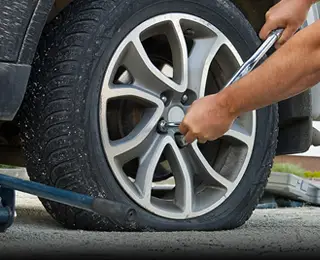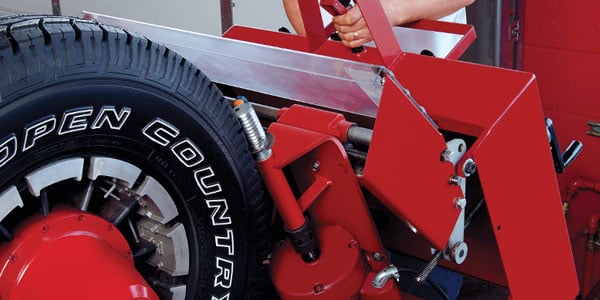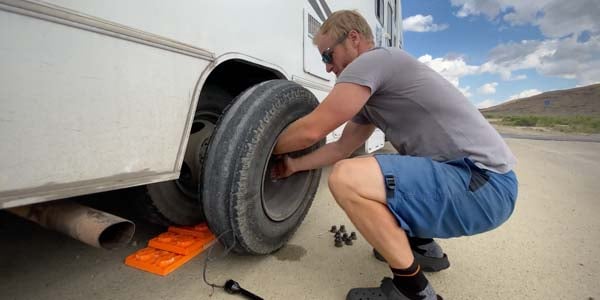How To Change a Tire
Changing a tire when you have a flat is easy when you understand some of the basics. The professionals at Les Schwab have some tips to help you properly change your tire so you can get safely back on the road.
Jump to Section:
Find a Safe Location
Park, Set Parking Brake, and Turn on Hazards
Confirm You Have the Correct Tools
Jack the Car Up in the Correct Location
Loosen Lug Nuts
Finish Lifting Car Off the Ground
Remove Lug Nuts
Remove Tire and Wheel
Install Spare Tire
Reinstall Lug Nuts Finger Tight
Lower Jack and Tighten Lug Nuts
Lug Nut Tightening Patterns
Lower Vehicle the Rest of the Way
Things to Know About Your Spare
The spare tire that came with your vehicle is either a space-saver spare, full-size spare, or an expandable/inflatable spare. Cars that do not have a spare often come with a sealant kit or other quick-fix option. They might also come equipped with run-flat tires, which can still go flat, but are designed to help you stay in control in the event of sudden loss of tire pressure.
Whatever type of spare you have, they are meant to be used temporarily to get from where you discovered your flat tire to the nearest tire repair shop. Spare tires can impact drivability and stopping power, which can reduce your overall control. For your safety, keep speeds at or below 50 miles per hour and drive no more than 50 miles when using a spare tire.
When you have a flat, get to your local Les Schwab. We have the tools and experience necessary to fix your flat, double-check your spare, and reinstall your wheel and tire assembly.
How to Change a Tire: Step-by-Step Guide
1. Find a Safe Location to Change the Tire
For your safety and the safety of others, try to change your tire in a parking lot or as far off the side of the road as possible.

2. Park, Set Parking Brake, and Turn on Hazards
Once you’re in a safe location, put your car in park (or first gear if you have a manual), set the parking brake, and turn on your hazard lights. This will help keep your car in place while also alerting other drivers.
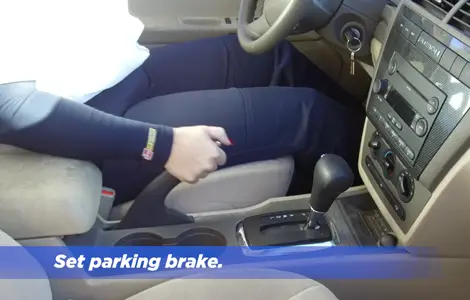
3. Confirm You Have the Correct Tools
The tools you need include a jack, lug wrench, and spare tire. These are usually stored in a compartment inside the trunk, under the floorboard of the hatch, or behind the back seat. There should also be instructions on how to use the jack.
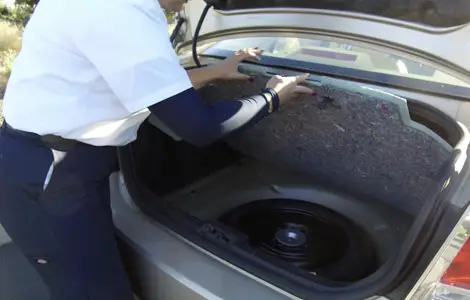
4. Jack the Car Up in the Correct Location
Using the instructions that came with your vehicle, set the jack in the proper location for the tire you want to change. This jack point helps ensure you can safely raise your vehicle without damaging it or injuring yourself. Start to jack up the vehicle less than a quarter of an inch. Before raising the vehicle, you’ll need to loosen the lug nuts.

5. Loosen Lug Nuts
Using the lug wrench, give each lug on your wheel a little more than a quarter turn. Loosening them now will make it a lot easier to completely loosen them once you lift the flat tire off the ground.

6. Finish Lifting Car Off the Ground with the Jack
Raise the vehicle until the tire is no longer touching the ground. Usually, upwards of an inch of clearance will be enough.

7. Remove Lug Nuts
Once the tire is off the ground, remove each of the lug nuts. This can often be done with the wrench or your fingers. When removing the last lug, hold the wheel and tire assembly in place so it doesn’t fall off. Finally, place each of the lugs in a safe location so they don’t roll away, get dirty, or lost.
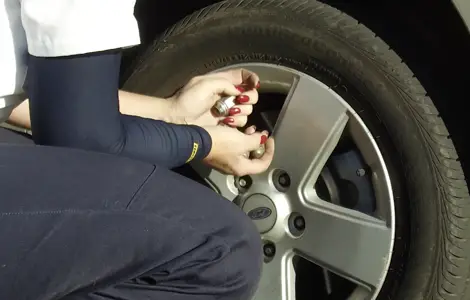
8. Remove Tire and Wheel
Slide the wheel off the wheel studs. For added safety, place the flat tire behind the jack and under the vehicle. Now it’s time to put on the spare.
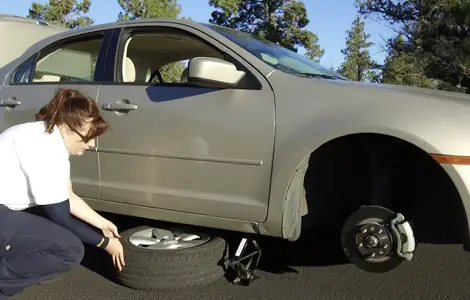
9. Install Spare Tire
Before installing the spare, make sure the valve stem is facing out. You don’t want the valve stem facing the car. Then, simply line up the holes on the wheel with the wheel studs on the car. Finally, push the spare tire into place. With one hand, hold the tire steady and install the lug nuts with the other.
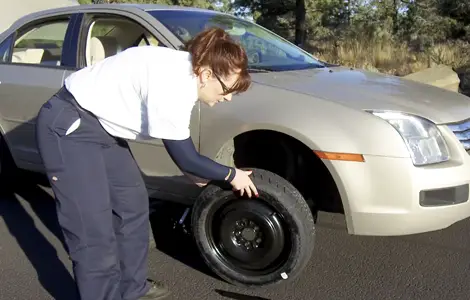
10. Reinstall Lug Nuts Finger Tight
You don’t want the lugs to be too tight, so simply tighten them by hand for now.
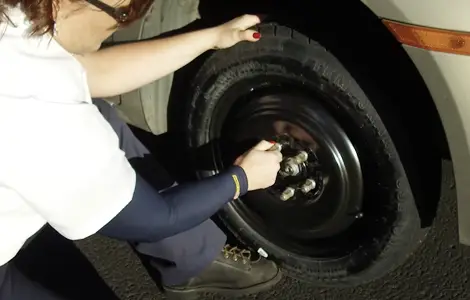
11. Lower the Vehicle Down (Almost all the way)
Lower the vehicle down until the tire barely rests on the ground.
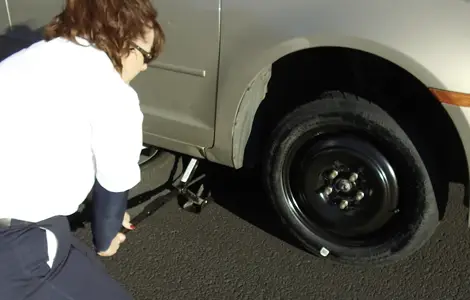
12. Tighten the Lug Nuts
The number of wheel bolts and lug nuts you have for each of your tires determines the patterns you should follow when tightening the lugs with your wrench. For example, if you have five lugs, follow the 5-lug star pattern.
4-lug Tightening Pattern
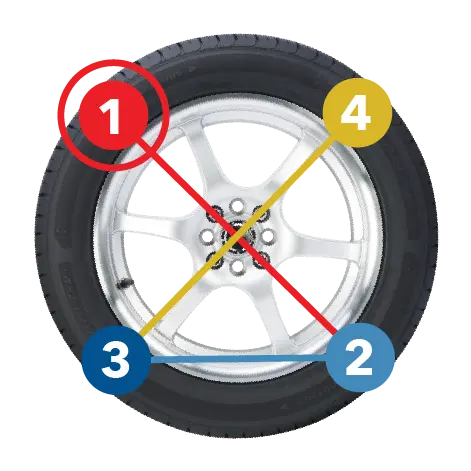
5-lug Tightening Pattern
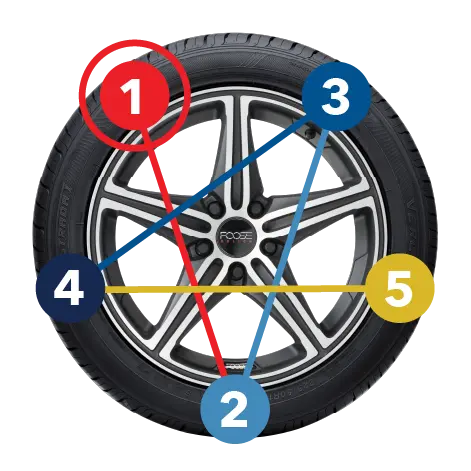
6-lug Tightening Pattern
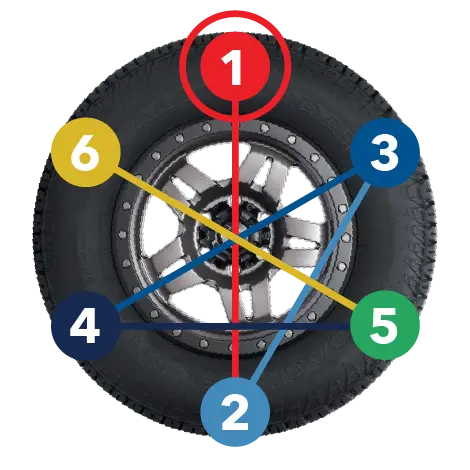
8-lug Tightening Pattern
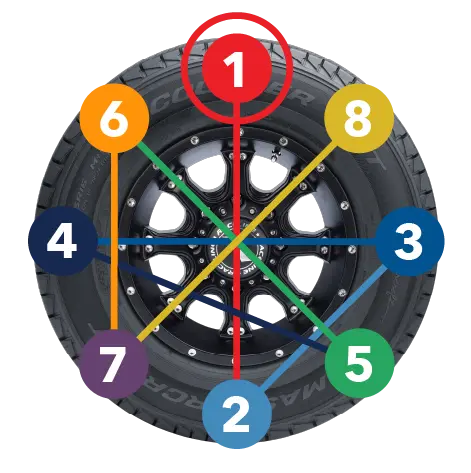
13. Lower Vehicle the Rest of the Way
Move your flat tire out from behind the jack, then lower the vehicle the rest of the way to the ground. Finally, remove the jack from below the car or truck and make sure you put your tools and flat tire in the trunk or other out-of-the-way location.
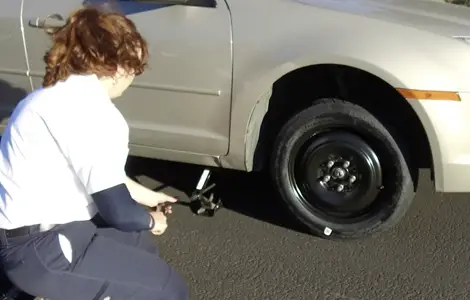
Get Back on the Road with Free Tire Repairs at Les Schwab
Les Schwab has you covered, whether your tire pressure is low or you’ve got a flat. We offer free repairs for most repairable Les Schwab tires on passenger vehicles. Plus, we work fast to get you back on the road safely. Visit your nearest Les Schwab or schedule an appointment online today.

